Offender Management: Theories, Sentences, and Organizations
VerifiedAdded on 2023/06/10
|9
|3814
|324
Report
AI Summary
This report provides a comprehensive overview of offender management within the context of the UK justice system. It begins by outlining various theories of punishment, including retribution, incapacitation, deterrence, rehabilitation, and reparation, and differentiates between custodial and community sentences. The report then examines the roles of government and non-governmental organizations, such as the National Offender Management Service (NOMS) and Community Rehabilitation Companies (CRC), in managing offenders through strategies like inter-structural management, local outcome initiatives, information collection, and rehabilitation programs. Furthermore, the report discusses the benefits of offender management for the community, focusing on rehabilitation, probation, parole, and the use of GPS tracking. The analysis is contextualized with reference to the Soham murders case, illustrating the practical application and challenges of offender management in preventing re-offending and protecting the public.

Unit 50 Offender
Management
INTRODUCTION
Offender management can be defined as a process in which the offender managers administer the
Management
INTRODUCTION
Offender management can be defined as a process in which the offender managers administer the
Paraphrase This Document
Need a fresh take? Get an instant paraphrase of this document with our AI Paraphraser
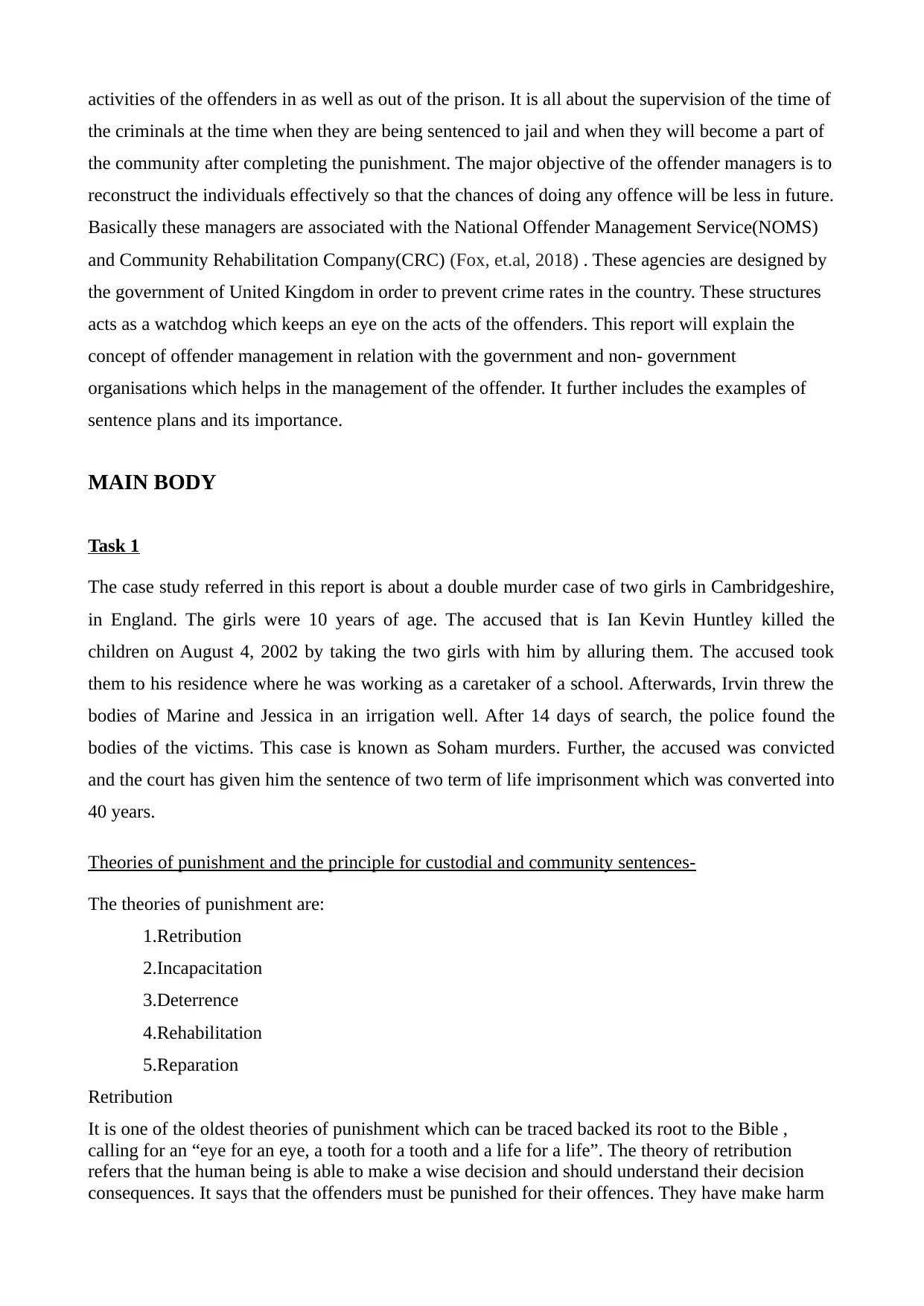
activities of the offenders in as well as out of the prison. It is all about the supervision of the time of
the criminals at the time when they are being sentenced to jail and when they will become a part of
the community after completing the punishment. The major objective of the offender managers is to
reconstruct the individuals effectively so that the chances of doing any offence will be less in future.
Basically these managers are associated with the National Offender Management Service(NOMS)
and Community Rehabilitation Company(CRC) (Fox, et.al, 2018) . These agencies are designed by
the government of United Kingdom in order to prevent crime rates in the country. These structures
acts as a watchdog which keeps an eye on the acts of the offenders. This report will explain the
concept of offender management in relation with the government and non- government
organisations which helps in the management of the offender. It further includes the examples of
sentence plans and its importance.
MAIN BODY
Task 1
The case study referred in this report is about a double murder case of two girls in Cambridgeshire,
in England. The girls were 10 years of age. The accused that is Ian Kevin Huntley killed the
children on August 4, 2002 by taking the two girls with him by alluring them. The accused took
them to his residence where he was working as a caretaker of a school. Afterwards, Irvin threw the
bodies of Marine and Jessica in an irrigation well. After 14 days of search, the police found the
bodies of the victims. This case is known as Soham murders. Further, the accused was convicted
and the court has given him the sentence of two term of life imprisonment which was converted into
40 years.
Theories of punishment and the principle for custodial and community sentences-
The theories of punishment are:
1.Retribution
2.Incapacitation
3.Deterrence
4.Rehabilitation
5.Reparation
Retribution
It is one of the oldest theories of punishment which can be traced backed its root to the Bible ,
calling for an “eye for an eye, a tooth for a tooth and a life for a life”. The theory of retribution
refers that the human being is able to make a wise decision and should understand their decision
consequences. It says that the offenders must be punished for their offences. They have make harm
the criminals at the time when they are being sentenced to jail and when they will become a part of
the community after completing the punishment. The major objective of the offender managers is to
reconstruct the individuals effectively so that the chances of doing any offence will be less in future.
Basically these managers are associated with the National Offender Management Service(NOMS)
and Community Rehabilitation Company(CRC) (Fox, et.al, 2018) . These agencies are designed by
the government of United Kingdom in order to prevent crime rates in the country. These structures
acts as a watchdog which keeps an eye on the acts of the offenders. This report will explain the
concept of offender management in relation with the government and non- government
organisations which helps in the management of the offender. It further includes the examples of
sentence plans and its importance.
MAIN BODY
Task 1
The case study referred in this report is about a double murder case of two girls in Cambridgeshire,
in England. The girls were 10 years of age. The accused that is Ian Kevin Huntley killed the
children on August 4, 2002 by taking the two girls with him by alluring them. The accused took
them to his residence where he was working as a caretaker of a school. Afterwards, Irvin threw the
bodies of Marine and Jessica in an irrigation well. After 14 days of search, the police found the
bodies of the victims. This case is known as Soham murders. Further, the accused was convicted
and the court has given him the sentence of two term of life imprisonment which was converted into
40 years.
Theories of punishment and the principle for custodial and community sentences-
The theories of punishment are:
1.Retribution
2.Incapacitation
3.Deterrence
4.Rehabilitation
5.Reparation
Retribution
It is one of the oldest theories of punishment which can be traced backed its root to the Bible ,
calling for an “eye for an eye, a tooth for a tooth and a life for a life”. The theory of retribution
refers that the human being is able to make a wise decision and should understand their decision
consequences. It says that the offenders must be punished for their offences. They have make harm
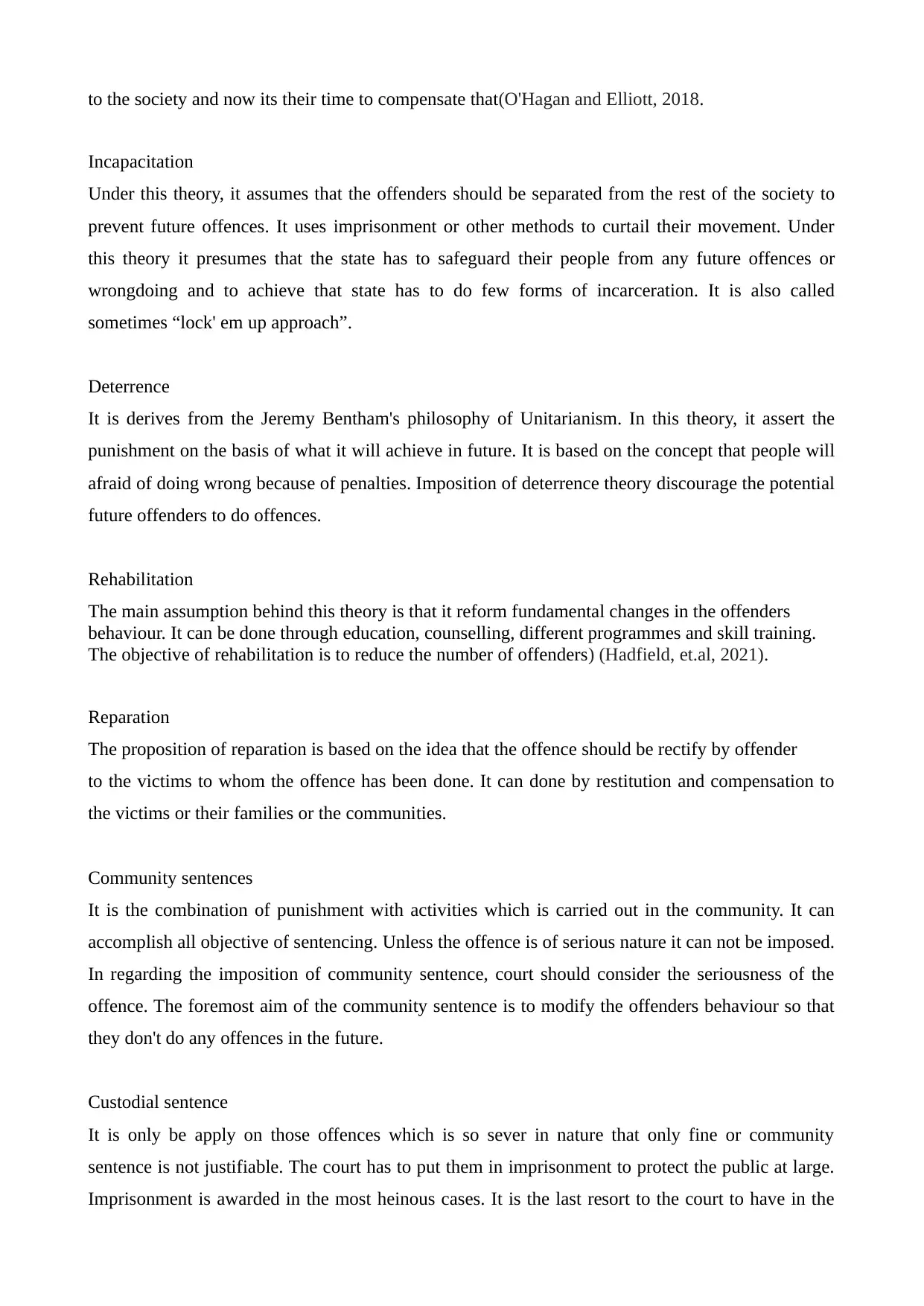
to the society and now its their time to compensate that(O'Hagan and Elliott, 2018.
Incapacitation
Under this theory, it assumes that the offenders should be separated from the rest of the society to
prevent future offences. It uses imprisonment or other methods to curtail their movement. Under
this theory it presumes that the state has to safeguard their people from any future offences or
wrongdoing and to achieve that state has to do few forms of incarceration. It is also called
sometimes “lock' em up approach”.
Deterrence
It is derives from the Jeremy Bentham's philosophy of Unitarianism. In this theory, it assert the
punishment on the basis of what it will achieve in future. It is based on the concept that people will
afraid of doing wrong because of penalties. Imposition of deterrence theory discourage the potential
future offenders to do offences.
Rehabilitation
The main assumption behind this theory is that it reform fundamental changes in the offenders
behaviour. It can be done through education, counselling, different programmes and skill training.
The objective of rehabilitation is to reduce the number of offenders) (Hadfield, et.al, 2021).
Reparation
The proposition of reparation is based on the idea that the offence should be rectify by offender
to the victims to whom the offence has been done. It can done by restitution and compensation to
the victims or their families or the communities.
Community sentences
It is the combination of punishment with activities which is carried out in the community. It can
accomplish all objective of sentencing. Unless the offence is of serious nature it can not be imposed.
In regarding the imposition of community sentence, court should consider the seriousness of the
offence. The foremost aim of the community sentence is to modify the offenders behaviour so that
they don't do any offences in the future.
Custodial sentence
It is only be apply on those offences which is so sever in nature that only fine or community
sentence is not justifiable. The court has to put them in imprisonment to protect the public at large.
Imprisonment is awarded in the most heinous cases. It is the last resort to the court to have in the
Incapacitation
Under this theory, it assumes that the offenders should be separated from the rest of the society to
prevent future offences. It uses imprisonment or other methods to curtail their movement. Under
this theory it presumes that the state has to safeguard their people from any future offences or
wrongdoing and to achieve that state has to do few forms of incarceration. It is also called
sometimes “lock' em up approach”.
Deterrence
It is derives from the Jeremy Bentham's philosophy of Unitarianism. In this theory, it assert the
punishment on the basis of what it will achieve in future. It is based on the concept that people will
afraid of doing wrong because of penalties. Imposition of deterrence theory discourage the potential
future offenders to do offences.
Rehabilitation
The main assumption behind this theory is that it reform fundamental changes in the offenders
behaviour. It can be done through education, counselling, different programmes and skill training.
The objective of rehabilitation is to reduce the number of offenders) (Hadfield, et.al, 2021).
Reparation
The proposition of reparation is based on the idea that the offence should be rectify by offender
to the victims to whom the offence has been done. It can done by restitution and compensation to
the victims or their families or the communities.
Community sentences
It is the combination of punishment with activities which is carried out in the community. It can
accomplish all objective of sentencing. Unless the offence is of serious nature it can not be imposed.
In regarding the imposition of community sentence, court should consider the seriousness of the
offence. The foremost aim of the community sentence is to modify the offenders behaviour so that
they don't do any offences in the future.
Custodial sentence
It is only be apply on those offences which is so sever in nature that only fine or community
sentence is not justifiable. The court has to put them in imprisonment to protect the public at large.
Imprisonment is awarded in the most heinous cases. It is the last resort to the court to have in the
⊘ This is a preview!⊘
Do you want full access?
Subscribe today to unlock all pages.

Trusted by 1+ million students worldwide
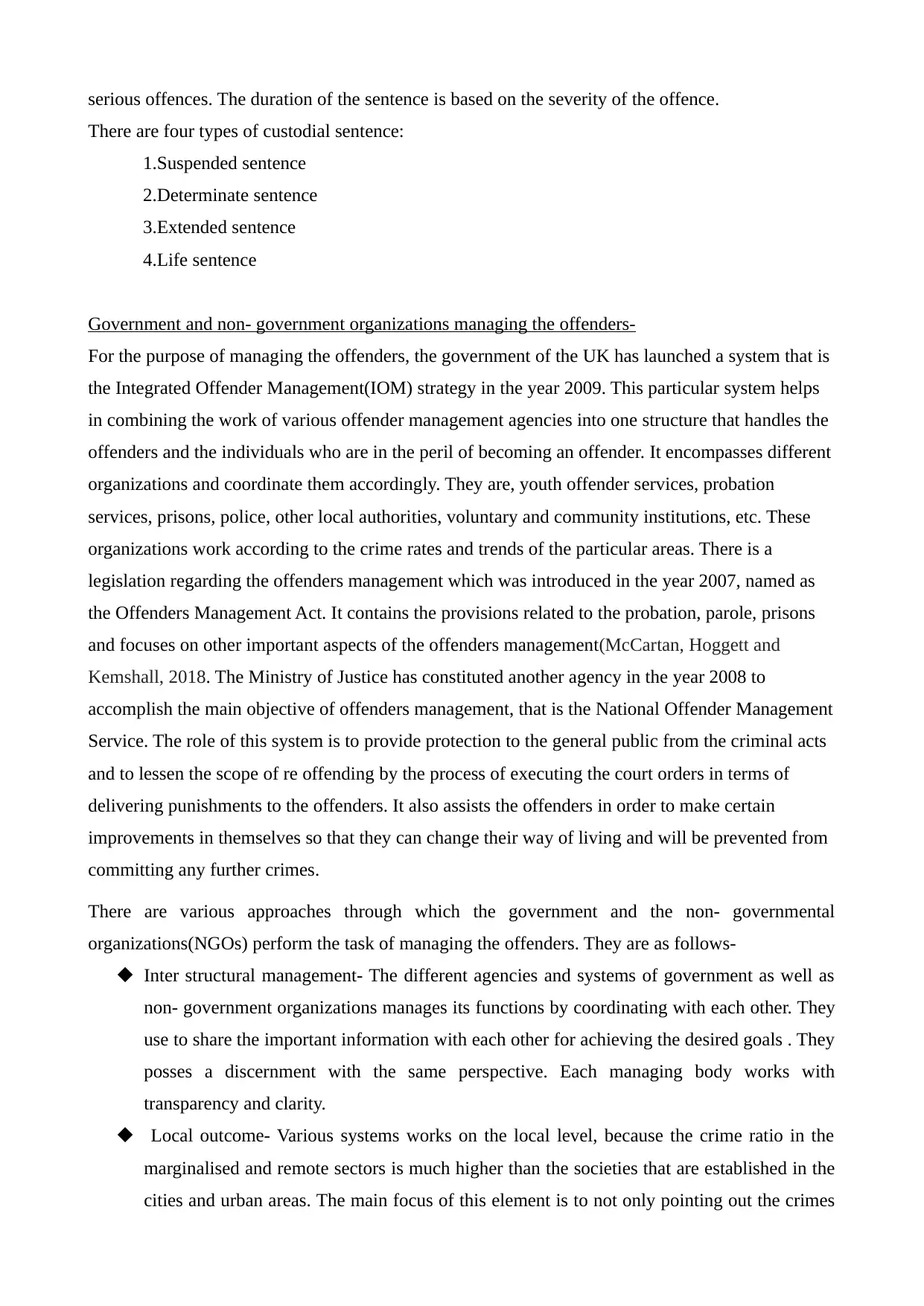
serious offences. The duration of the sentence is based on the severity of the offence.
There are four types of custodial sentence:
1.Suspended sentence
2.Determinate sentence
3.Extended sentence
4.Life sentence
Government and non- government organizations managing the offenders-
For the purpose of managing the offenders, the government of the UK has launched a system that is
the Integrated Offender Management(IOM) strategy in the year 2009. This particular system helps
in combining the work of various offender management agencies into one structure that handles the
offenders and the individuals who are in the peril of becoming an offender. It encompasses different
organizations and coordinate them accordingly. They are, youth offender services, probation
services, prisons, police, other local authorities, voluntary and community institutions, etc. These
organizations work according to the crime rates and trends of the particular areas. There is a
legislation regarding the offenders management which was introduced in the year 2007, named as
the Offenders Management Act. It contains the provisions related to the probation, parole, prisons
and focuses on other important aspects of the offenders management(McCartan, Hoggett and
Kemshall, 2018. The Ministry of Justice has constituted another agency in the year 2008 to
accomplish the main objective of offenders management, that is the National Offender Management
Service. The role of this system is to provide protection to the general public from the criminal acts
and to lessen the scope of re offending by the process of executing the court orders in terms of
delivering punishments to the offenders. It also assists the offenders in order to make certain
improvements in themselves so that they can change their way of living and will be prevented from
committing any further crimes.
There are various approaches through which the government and the non- governmental
organizations(NGOs) perform the task of managing the offenders. They are as follows-
Inter structural management- The different agencies and systems of government as well as
non- government organizations manages its functions by coordinating with each other. They
use to share the important information with each other for achieving the desired goals . They
posses a discernment with the same perspective. Each managing body works with
transparency and clarity.
Local outcome- Various systems works on the local level, because the crime ratio in the
marginalised and remote sectors is much higher than the societies that are established in the
cities and urban areas. The main focus of this element is to not only pointing out the crimes
There are four types of custodial sentence:
1.Suspended sentence
2.Determinate sentence
3.Extended sentence
4.Life sentence
Government and non- government organizations managing the offenders-
For the purpose of managing the offenders, the government of the UK has launched a system that is
the Integrated Offender Management(IOM) strategy in the year 2009. This particular system helps
in combining the work of various offender management agencies into one structure that handles the
offenders and the individuals who are in the peril of becoming an offender. It encompasses different
organizations and coordinate them accordingly. They are, youth offender services, probation
services, prisons, police, other local authorities, voluntary and community institutions, etc. These
organizations work according to the crime rates and trends of the particular areas. There is a
legislation regarding the offenders management which was introduced in the year 2007, named as
the Offenders Management Act. It contains the provisions related to the probation, parole, prisons
and focuses on other important aspects of the offenders management(McCartan, Hoggett and
Kemshall, 2018. The Ministry of Justice has constituted another agency in the year 2008 to
accomplish the main objective of offenders management, that is the National Offender Management
Service. The role of this system is to provide protection to the general public from the criminal acts
and to lessen the scope of re offending by the process of executing the court orders in terms of
delivering punishments to the offenders. It also assists the offenders in order to make certain
improvements in themselves so that they can change their way of living and will be prevented from
committing any further crimes.
There are various approaches through which the government and the non- governmental
organizations(NGOs) perform the task of managing the offenders. They are as follows-
Inter structural management- The different agencies and systems of government as well as
non- government organizations manages its functions by coordinating with each other. They
use to share the important information with each other for achieving the desired goals . They
posses a discernment with the same perspective. Each managing body works with
transparency and clarity.
Local outcome- Various systems works on the local level, because the crime ratio in the
marginalised and remote sectors is much higher than the societies that are established in the
cities and urban areas. The main focus of this element is to not only pointing out the crimes
Paraphrase This Document
Need a fresh take? Get an instant paraphrase of this document with our AI Paraphraser
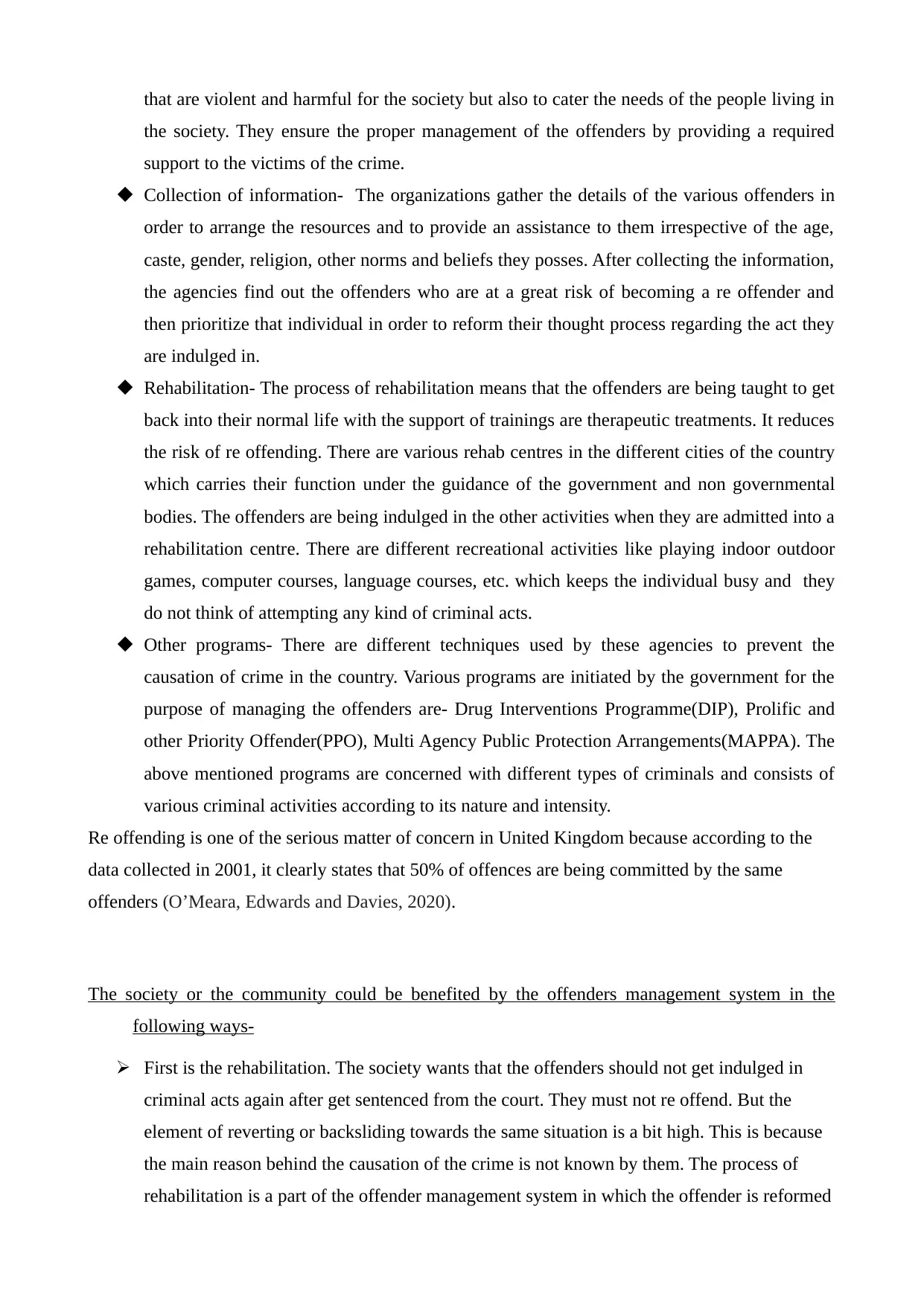
that are violent and harmful for the society but also to cater the needs of the people living in
the society. They ensure the proper management of the offenders by providing a required
support to the victims of the crime.
Collection of information- The organizations gather the details of the various offenders in
order to arrange the resources and to provide an assistance to them irrespective of the age,
caste, gender, religion, other norms and beliefs they posses. After collecting the information,
the agencies find out the offenders who are at a great risk of becoming a re offender and
then prioritize that individual in order to reform their thought process regarding the act they
are indulged in.
Rehabilitation- The process of rehabilitation means that the offenders are being taught to get
back into their normal life with the support of trainings are therapeutic treatments. It reduces
the risk of re offending. There are various rehab centres in the different cities of the country
which carries their function under the guidance of the government and non governmental
bodies. The offenders are being indulged in the other activities when they are admitted into a
rehabilitation centre. There are different recreational activities like playing indoor outdoor
games, computer courses, language courses, etc. which keeps the individual busy and they
do not think of attempting any kind of criminal acts.
Other programs- There are different techniques used by these agencies to prevent the
causation of crime in the country. Various programs are initiated by the government for the
purpose of managing the offenders are- Drug Interventions Programme(DIP), Prolific and
other Priority Offender(PPO), Multi Agency Public Protection Arrangements(MAPPA). The
above mentioned programs are concerned with different types of criminals and consists of
various criminal activities according to its nature and intensity.
Re offending is one of the serious matter of concern in United Kingdom because according to the
data collected in 2001, it clearly states that 50% of offences are being committed by the same
offenders (O’Meara, Edwards and Davies, 2020).
The society or the community could be benefited by the offenders management system in the
following ways-
First is the rehabilitation. The society wants that the offenders should not get indulged in
criminal acts again after get sentenced from the court. They must not re offend. But the
element of reverting or backsliding towards the same situation is a bit high. This is because
the main reason behind the causation of the crime is not known by them. The process of
rehabilitation is a part of the offender management system in which the offender is reformed
the society. They ensure the proper management of the offenders by providing a required
support to the victims of the crime.
Collection of information- The organizations gather the details of the various offenders in
order to arrange the resources and to provide an assistance to them irrespective of the age,
caste, gender, religion, other norms and beliefs they posses. After collecting the information,
the agencies find out the offenders who are at a great risk of becoming a re offender and
then prioritize that individual in order to reform their thought process regarding the act they
are indulged in.
Rehabilitation- The process of rehabilitation means that the offenders are being taught to get
back into their normal life with the support of trainings are therapeutic treatments. It reduces
the risk of re offending. There are various rehab centres in the different cities of the country
which carries their function under the guidance of the government and non governmental
bodies. The offenders are being indulged in the other activities when they are admitted into a
rehabilitation centre. There are different recreational activities like playing indoor outdoor
games, computer courses, language courses, etc. which keeps the individual busy and they
do not think of attempting any kind of criminal acts.
Other programs- There are different techniques used by these agencies to prevent the
causation of crime in the country. Various programs are initiated by the government for the
purpose of managing the offenders are- Drug Interventions Programme(DIP), Prolific and
other Priority Offender(PPO), Multi Agency Public Protection Arrangements(MAPPA). The
above mentioned programs are concerned with different types of criminals and consists of
various criminal activities according to its nature and intensity.
Re offending is one of the serious matter of concern in United Kingdom because according to the
data collected in 2001, it clearly states that 50% of offences are being committed by the same
offenders (O’Meara, Edwards and Davies, 2020).
The society or the community could be benefited by the offenders management system in the
following ways-
First is the rehabilitation. The society wants that the offenders should not get indulged in
criminal acts again after get sentenced from the court. They must not re offend. But the
element of reverting or backsliding towards the same situation is a bit high. This is because
the main reason behind the causation of the crime is not known by them. The process of
rehabilitation is a part of the offender management system in which the offender is reformed
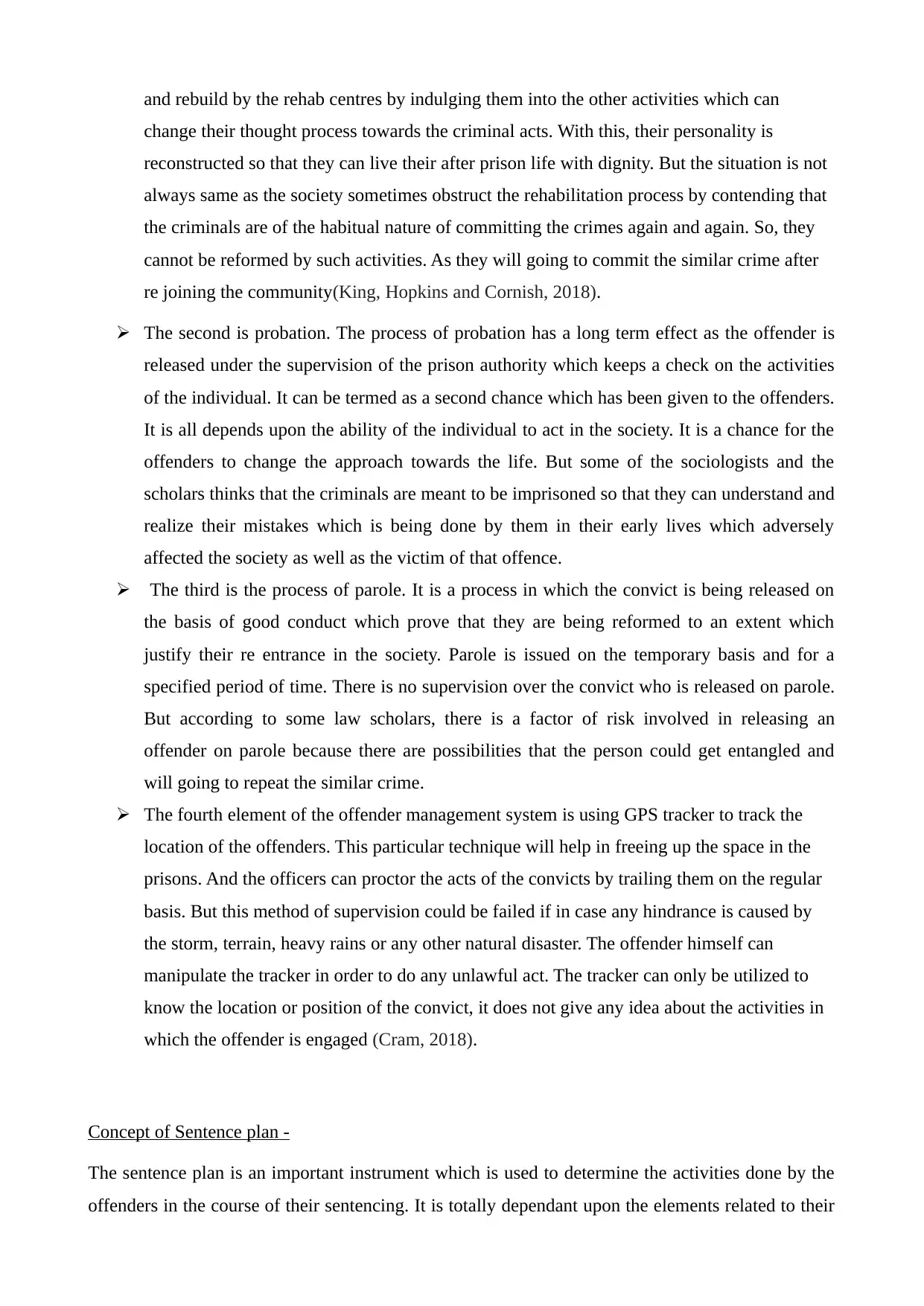
and rebuild by the rehab centres by indulging them into the other activities which can
change their thought process towards the criminal acts. With this, their personality is
reconstructed so that they can live their after prison life with dignity. But the situation is not
always same as the society sometimes obstruct the rehabilitation process by contending that
the criminals are of the habitual nature of committing the crimes again and again. So, they
cannot be reformed by such activities. As they will going to commit the similar crime after
re joining the community(King, Hopkins and Cornish, 2018).
The second is probation. The process of probation has a long term effect as the offender is
released under the supervision of the prison authority which keeps a check on the activities
of the individual. It can be termed as a second chance which has been given to the offenders.
It is all depends upon the ability of the individual to act in the society. It is a chance for the
offenders to change the approach towards the life. But some of the sociologists and the
scholars thinks that the criminals are meant to be imprisoned so that they can understand and
realize their mistakes which is being done by them in their early lives which adversely
affected the society as well as the victim of that offence.
The third is the process of parole. It is a process in which the convict is being released on
the basis of good conduct which prove that they are being reformed to an extent which
justify their re entrance in the society. Parole is issued on the temporary basis and for a
specified period of time. There is no supervision over the convict who is released on parole.
But according to some law scholars, there is a factor of risk involved in releasing an
offender on parole because there are possibilities that the person could get entangled and
will going to repeat the similar crime.
The fourth element of the offender management system is using GPS tracker to track the
location of the offenders. This particular technique will help in freeing up the space in the
prisons. And the officers can proctor the acts of the convicts by trailing them on the regular
basis. But this method of supervision could be failed if in case any hindrance is caused by
the storm, terrain, heavy rains or any other natural disaster. The offender himself can
manipulate the tracker in order to do any unlawful act. The tracker can only be utilized to
know the location or position of the convict, it does not give any idea about the activities in
which the offender is engaged (Cram, 2018).
Concept of Sentence plan -
The sentence plan is an important instrument which is used to determine the activities done by the
offenders in the course of their sentencing. It is totally dependant upon the elements related to their
change their thought process towards the criminal acts. With this, their personality is
reconstructed so that they can live their after prison life with dignity. But the situation is not
always same as the society sometimes obstruct the rehabilitation process by contending that
the criminals are of the habitual nature of committing the crimes again and again. So, they
cannot be reformed by such activities. As they will going to commit the similar crime after
re joining the community(King, Hopkins and Cornish, 2018).
The second is probation. The process of probation has a long term effect as the offender is
released under the supervision of the prison authority which keeps a check on the activities
of the individual. It can be termed as a second chance which has been given to the offenders.
It is all depends upon the ability of the individual to act in the society. It is a chance for the
offenders to change the approach towards the life. But some of the sociologists and the
scholars thinks that the criminals are meant to be imprisoned so that they can understand and
realize their mistakes which is being done by them in their early lives which adversely
affected the society as well as the victim of that offence.
The third is the process of parole. It is a process in which the convict is being released on
the basis of good conduct which prove that they are being reformed to an extent which
justify their re entrance in the society. Parole is issued on the temporary basis and for a
specified period of time. There is no supervision over the convict who is released on parole.
But according to some law scholars, there is a factor of risk involved in releasing an
offender on parole because there are possibilities that the person could get entangled and
will going to repeat the similar crime.
The fourth element of the offender management system is using GPS tracker to track the
location of the offenders. This particular technique will help in freeing up the space in the
prisons. And the officers can proctor the acts of the convicts by trailing them on the regular
basis. But this method of supervision could be failed if in case any hindrance is caused by
the storm, terrain, heavy rains or any other natural disaster. The offender himself can
manipulate the tracker in order to do any unlawful act. The tracker can only be utilized to
know the location or position of the convict, it does not give any idea about the activities in
which the offender is engaged (Cram, 2018).
Concept of Sentence plan -
The sentence plan is an important instrument which is used to determine the activities done by the
offenders in the course of their sentencing. It is totally dependant upon the elements related to their
⊘ This is a preview!⊘
Do you want full access?
Subscribe today to unlock all pages.

Trusted by 1+ million students worldwide
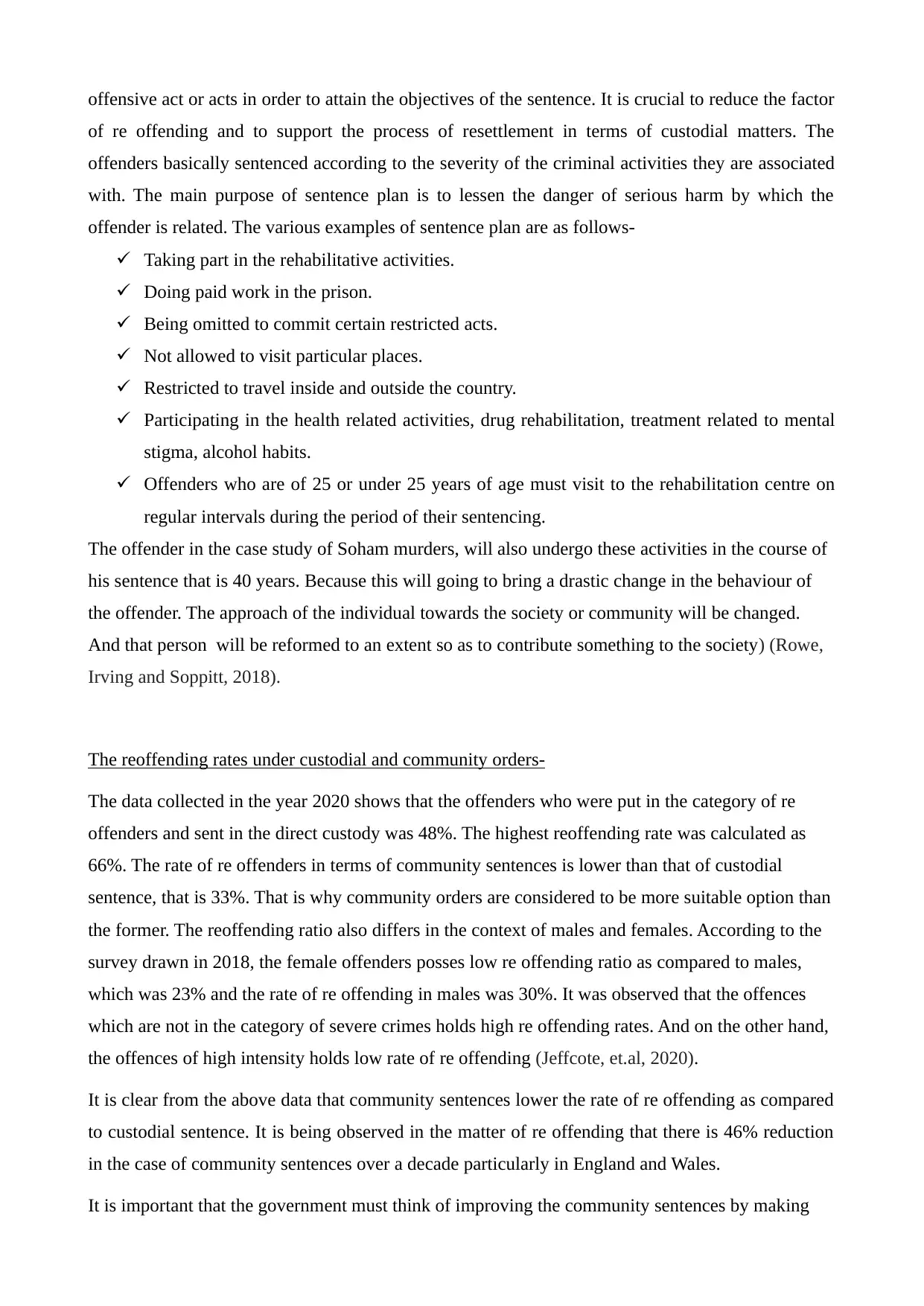
offensive act or acts in order to attain the objectives of the sentence. It is crucial to reduce the factor
of re offending and to support the process of resettlement in terms of custodial matters. The
offenders basically sentenced according to the severity of the criminal activities they are associated
with. The main purpose of sentence plan is to lessen the danger of serious harm by which the
offender is related. The various examples of sentence plan are as follows-
Taking part in the rehabilitative activities.
Doing paid work in the prison.
Being omitted to commit certain restricted acts.
Not allowed to visit particular places.
Restricted to travel inside and outside the country.
Participating in the health related activities, drug rehabilitation, treatment related to mental
stigma, alcohol habits.
Offenders who are of 25 or under 25 years of age must visit to the rehabilitation centre on
regular intervals during the period of their sentencing.
The offender in the case study of Soham murders, will also undergo these activities in the course of
his sentence that is 40 years. Because this will going to bring a drastic change in the behaviour of
the offender. The approach of the individual towards the society or community will be changed.
And that person will be reformed to an extent so as to contribute something to the society) (Rowe,
Irving and Soppitt, 2018).
The reoffending rates under custodial and community orders-
The data collected in the year 2020 shows that the offenders who were put in the category of re
offenders and sent in the direct custody was 48%. The highest reoffending rate was calculated as
66%. The rate of re offenders in terms of community sentences is lower than that of custodial
sentence, that is 33%. That is why community orders are considered to be more suitable option than
the former. The reoffending ratio also differs in the context of males and females. According to the
survey drawn in 2018, the female offenders posses low re offending ratio as compared to males,
which was 23% and the rate of re offending in males was 30%. It was observed that the offences
which are not in the category of severe crimes holds high re offending rates. And on the other hand,
the offences of high intensity holds low rate of re offending (Jeffcote, et.al, 2020).
It is clear from the above data that community sentences lower the rate of re offending as compared
to custodial sentence. It is being observed in the matter of re offending that there is 46% reduction
in the case of community sentences over a decade particularly in England and Wales.
It is important that the government must think of improving the community sentences by making
of re offending and to support the process of resettlement in terms of custodial matters. The
offenders basically sentenced according to the severity of the criminal activities they are associated
with. The main purpose of sentence plan is to lessen the danger of serious harm by which the
offender is related. The various examples of sentence plan are as follows-
Taking part in the rehabilitative activities.
Doing paid work in the prison.
Being omitted to commit certain restricted acts.
Not allowed to visit particular places.
Restricted to travel inside and outside the country.
Participating in the health related activities, drug rehabilitation, treatment related to mental
stigma, alcohol habits.
Offenders who are of 25 or under 25 years of age must visit to the rehabilitation centre on
regular intervals during the period of their sentencing.
The offender in the case study of Soham murders, will also undergo these activities in the course of
his sentence that is 40 years. Because this will going to bring a drastic change in the behaviour of
the offender. The approach of the individual towards the society or community will be changed.
And that person will be reformed to an extent so as to contribute something to the society) (Rowe,
Irving and Soppitt, 2018).
The reoffending rates under custodial and community orders-
The data collected in the year 2020 shows that the offenders who were put in the category of re
offenders and sent in the direct custody was 48%. The highest reoffending rate was calculated as
66%. The rate of re offenders in terms of community sentences is lower than that of custodial
sentence, that is 33%. That is why community orders are considered to be more suitable option than
the former. The reoffending ratio also differs in the context of males and females. According to the
survey drawn in 2018, the female offenders posses low re offending ratio as compared to males,
which was 23% and the rate of re offending in males was 30%. It was observed that the offences
which are not in the category of severe crimes holds high re offending rates. And on the other hand,
the offences of high intensity holds low rate of re offending (Jeffcote, et.al, 2020).
It is clear from the above data that community sentences lower the rate of re offending as compared
to custodial sentence. It is being observed in the matter of re offending that there is 46% reduction
in the case of community sentences over a decade particularly in England and Wales.
It is important that the government must think of improving the community sentences by making
Paraphrase This Document
Need a fresh take? Get an instant paraphrase of this document with our AI Paraphraser
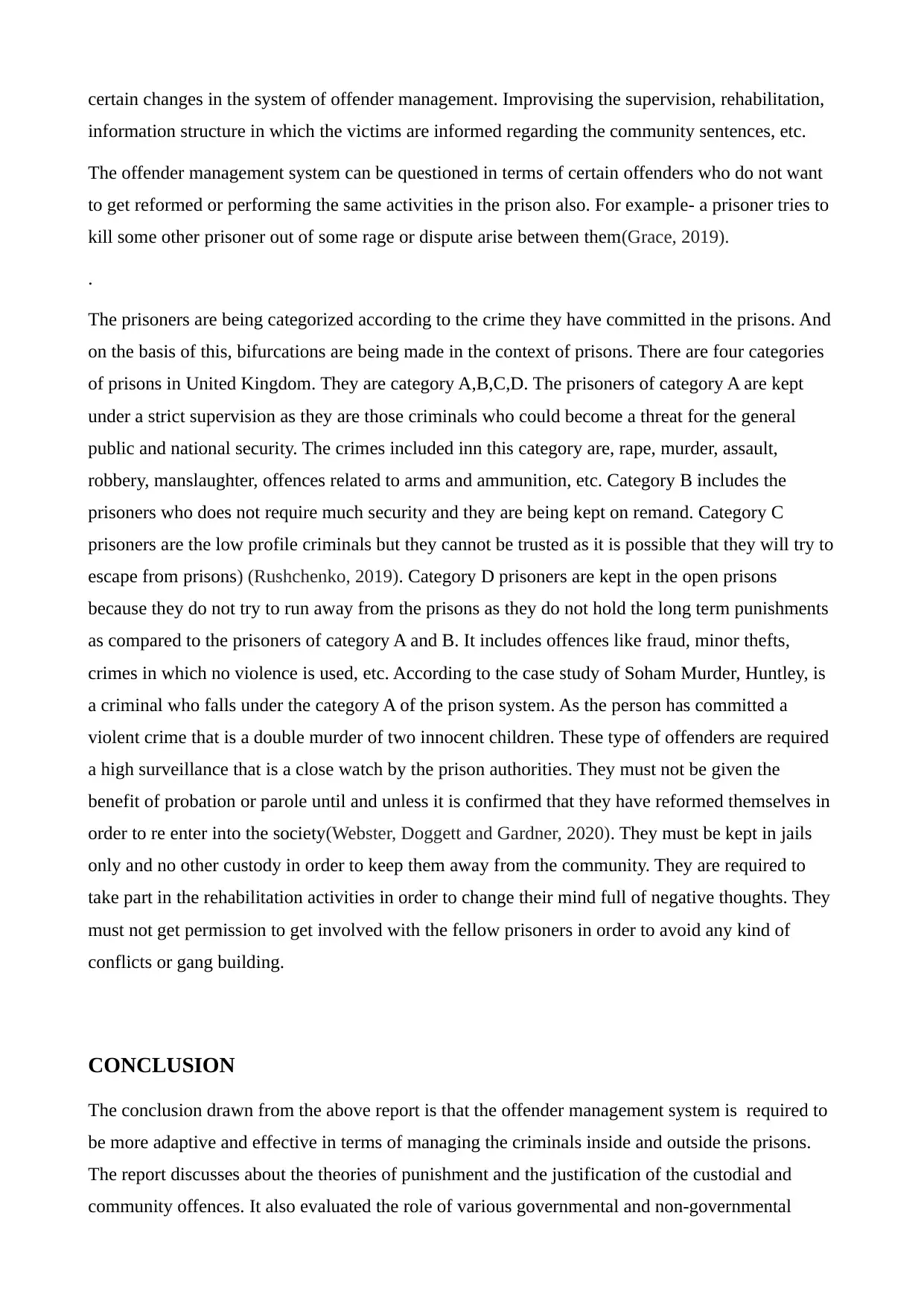
certain changes in the system of offender management. Improvising the supervision, rehabilitation,
information structure in which the victims are informed regarding the community sentences, etc.
The offender management system can be questioned in terms of certain offenders who do not want
to get reformed or performing the same activities in the prison also. For example- a prisoner tries to
kill some other prisoner out of some rage or dispute arise between them(Grace, 2019).
.
The prisoners are being categorized according to the crime they have committed in the prisons. And
on the basis of this, bifurcations are being made in the context of prisons. There are four categories
of prisons in United Kingdom. They are category A,B,C,D. The prisoners of category A are kept
under a strict supervision as they are those criminals who could become a threat for the general
public and national security. The crimes included inn this category are, rape, murder, assault,
robbery, manslaughter, offences related to arms and ammunition, etc. Category B includes the
prisoners who does not require much security and they are being kept on remand. Category C
prisoners are the low profile criminals but they cannot be trusted as it is possible that they will try to
escape from prisons) (Rushchenko, 2019). Category D prisoners are kept in the open prisons
because they do not try to run away from the prisons as they do not hold the long term punishments
as compared to the prisoners of category A and B. It includes offences like fraud, minor thefts,
crimes in which no violence is used, etc. According to the case study of Soham Murder, Huntley, is
a criminal who falls under the category A of the prison system. As the person has committed a
violent crime that is a double murder of two innocent children. These type of offenders are required
a high surveillance that is a close watch by the prison authorities. They must not be given the
benefit of probation or parole until and unless it is confirmed that they have reformed themselves in
order to re enter into the society(Webster, Doggett and Gardner, 2020). They must be kept in jails
only and no other custody in order to keep them away from the community. They are required to
take part in the rehabilitation activities in order to change their mind full of negative thoughts. They
must not get permission to get involved with the fellow prisoners in order to avoid any kind of
conflicts or gang building.
CONCLUSION
The conclusion drawn from the above report is that the offender management system is required to
be more adaptive and effective in terms of managing the criminals inside and outside the prisons.
The report discusses about the theories of punishment and the justification of the custodial and
community offences. It also evaluated the role of various governmental and non-governmental
information structure in which the victims are informed regarding the community sentences, etc.
The offender management system can be questioned in terms of certain offenders who do not want
to get reformed or performing the same activities in the prison also. For example- a prisoner tries to
kill some other prisoner out of some rage or dispute arise between them(Grace, 2019).
.
The prisoners are being categorized according to the crime they have committed in the prisons. And
on the basis of this, bifurcations are being made in the context of prisons. There are four categories
of prisons in United Kingdom. They are category A,B,C,D. The prisoners of category A are kept
under a strict supervision as they are those criminals who could become a threat for the general
public and national security. The crimes included inn this category are, rape, murder, assault,
robbery, manslaughter, offences related to arms and ammunition, etc. Category B includes the
prisoners who does not require much security and they are being kept on remand. Category C
prisoners are the low profile criminals but they cannot be trusted as it is possible that they will try to
escape from prisons) (Rushchenko, 2019). Category D prisoners are kept in the open prisons
because they do not try to run away from the prisons as they do not hold the long term punishments
as compared to the prisoners of category A and B. It includes offences like fraud, minor thefts,
crimes in which no violence is used, etc. According to the case study of Soham Murder, Huntley, is
a criminal who falls under the category A of the prison system. As the person has committed a
violent crime that is a double murder of two innocent children. These type of offenders are required
a high surveillance that is a close watch by the prison authorities. They must not be given the
benefit of probation or parole until and unless it is confirmed that they have reformed themselves in
order to re enter into the society(Webster, Doggett and Gardner, 2020). They must be kept in jails
only and no other custody in order to keep them away from the community. They are required to
take part in the rehabilitation activities in order to change their mind full of negative thoughts. They
must not get permission to get involved with the fellow prisoners in order to avoid any kind of
conflicts or gang building.
CONCLUSION
The conclusion drawn from the above report is that the offender management system is required to
be more adaptive and effective in terms of managing the criminals inside and outside the prisons.
The report discusses about the theories of punishment and the justification of the custodial and
community offences. It also evaluated the role of various governmental and non-governmental
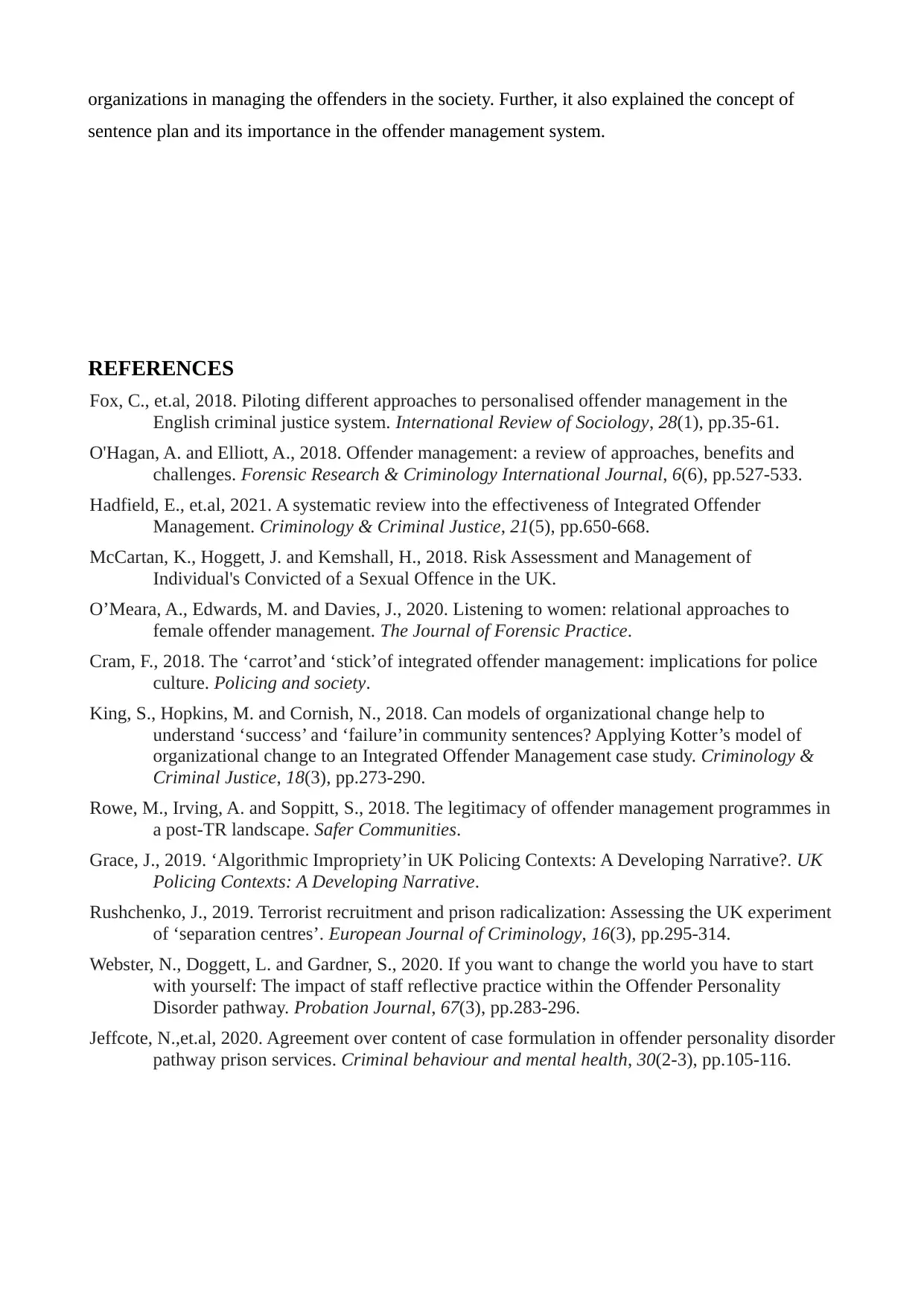
organizations in managing the offenders in the society. Further, it also explained the concept of
sentence plan and its importance in the offender management system.
REFERENCES
Fox, C., et.al, 2018. Piloting different approaches to personalised offender management in the
English criminal justice system. International Review of Sociology, 28(1), pp.35-61.
O'Hagan, A. and Elliott, A., 2018. Offender management: a review of approaches, benefits and
challenges. Forensic Research & Criminology International Journal, 6(6), pp.527-533.
Hadfield, E., et.al, 2021. A systematic review into the effectiveness of Integrated Offender
Management. Criminology & Criminal Justice, 21(5), pp.650-668.
McCartan, K., Hoggett, J. and Kemshall, H., 2018. Risk Assessment and Management of
Individual's Convicted of a Sexual Offence in the UK.
O’Meara, A., Edwards, M. and Davies, J., 2020. Listening to women: relational approaches to
female offender management. The Journal of Forensic Practice.
Cram, F., 2018. The ‘carrot’and ‘stick’of integrated offender management: implications for police
culture. Policing and society.
King, S., Hopkins, M. and Cornish, N., 2018. Can models of organizational change help to
understand ‘success’ and ‘failure’in community sentences? Applying Kotter’s model of
organizational change to an Integrated Offender Management case study. Criminology &
Criminal Justice, 18(3), pp.273-290.
Rowe, M., Irving, A. and Soppitt, S., 2018. The legitimacy of offender management programmes in
a post-TR landscape. Safer Communities.
Grace, J., 2019. ‘Algorithmic Impropriety’in UK Policing Contexts: A Developing Narrative?. UK
Policing Contexts: A Developing Narrative.
Rushchenko, J., 2019. Terrorist recruitment and prison radicalization: Assessing the UK experiment
of ‘separation centres’. European Journal of Criminology, 16(3), pp.295-314.
Webster, N., Doggett, L. and Gardner, S., 2020. If you want to change the world you have to start
with yourself: The impact of staff reflective practice within the Offender Personality
Disorder pathway. Probation Journal, 67(3), pp.283-296.
Jeffcote, N.,et.al, 2020. Agreement over content of case formulation in offender personality disorder
pathway prison services. Criminal behaviour and mental health, 30(2-3), pp.105-116.
sentence plan and its importance in the offender management system.
REFERENCES
Fox, C., et.al, 2018. Piloting different approaches to personalised offender management in the
English criminal justice system. International Review of Sociology, 28(1), pp.35-61.
O'Hagan, A. and Elliott, A., 2018. Offender management: a review of approaches, benefits and
challenges. Forensic Research & Criminology International Journal, 6(6), pp.527-533.
Hadfield, E., et.al, 2021. A systematic review into the effectiveness of Integrated Offender
Management. Criminology & Criminal Justice, 21(5), pp.650-668.
McCartan, K., Hoggett, J. and Kemshall, H., 2018. Risk Assessment and Management of
Individual's Convicted of a Sexual Offence in the UK.
O’Meara, A., Edwards, M. and Davies, J., 2020. Listening to women: relational approaches to
female offender management. The Journal of Forensic Practice.
Cram, F., 2018. The ‘carrot’and ‘stick’of integrated offender management: implications for police
culture. Policing and society.
King, S., Hopkins, M. and Cornish, N., 2018. Can models of organizational change help to
understand ‘success’ and ‘failure’in community sentences? Applying Kotter’s model of
organizational change to an Integrated Offender Management case study. Criminology &
Criminal Justice, 18(3), pp.273-290.
Rowe, M., Irving, A. and Soppitt, S., 2018. The legitimacy of offender management programmes in
a post-TR landscape. Safer Communities.
Grace, J., 2019. ‘Algorithmic Impropriety’in UK Policing Contexts: A Developing Narrative?. UK
Policing Contexts: A Developing Narrative.
Rushchenko, J., 2019. Terrorist recruitment and prison radicalization: Assessing the UK experiment
of ‘separation centres’. European Journal of Criminology, 16(3), pp.295-314.
Webster, N., Doggett, L. and Gardner, S., 2020. If you want to change the world you have to start
with yourself: The impact of staff reflective practice within the Offender Personality
Disorder pathway. Probation Journal, 67(3), pp.283-296.
Jeffcote, N.,et.al, 2020. Agreement over content of case formulation in offender personality disorder
pathway prison services. Criminal behaviour and mental health, 30(2-3), pp.105-116.
⊘ This is a preview!⊘
Do you want full access?
Subscribe today to unlock all pages.

Trusted by 1+ million students worldwide
1 out of 9
Related Documents
Your All-in-One AI-Powered Toolkit for Academic Success.
+13062052269
info@desklib.com
Available 24*7 on WhatsApp / Email
![[object Object]](/_next/static/media/star-bottom.7253800d.svg)
Unlock your academic potential
Copyright © 2020–2026 A2Z Services. All Rights Reserved. Developed and managed by ZUCOL.





